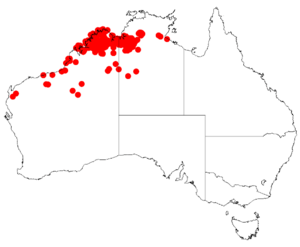Acacia translucens facts for kids
Acacia translucens, commonly known as poverty bush, is a special type of shrub. It grows naturally only in a large area of north-western Australia.
Quick facts for kids Acacia translucens |
|
|---|---|
| Scientific classification | |
| Genus: |
Acacia
|
| Species: |
translucens
|
 |
|
| Occurrence data from AVH | |
Contents
What is Poverty Bush?
The poverty bush is a low, spreading shrub with a flat top. It can grow from 0.5 to 3 m (1 ft 8 in to 9 ft 10 in) tall and about 1.5 m (4 ft 11 in) wide. Its branches start close to the ground. The bark is smooth and dark grey to black.
Leaves and Flowers
Like many Acacia plants from dry areas, the poverty bush has phyllodes instead of true leaves. Phyllodes are flattened leaf stems that look and act like leaves. These phyllodes are thin, leathery, and dull grey-green. They are curved and measure about 0.6 to 2 cm (0.24 to 0.79 in) long and 4 to 9 mm (0.16 to 0.35 in) wide. You can usually see three main lines, or nerves, on them.
This plant blooms between March and November. Its flowers are bright yellow and grow in round clusters. Each cluster is about 5 mm (0.20 in) across.
Seed Pods
After flowering, the plant forms seed pods. These pods stand upright above the leaves, which is different from most Acacia plants where pods hang down. The pods are brittle and woody, colored brown to black. They are narrow and shaped like a spear, measuring 2 to 5.5 cm (0.79 to 2.17 in) long and 4 to 10 mm (0.16 to 0.39 in) wide. They have slanted lines on them. Inside the pods are brown, oblong seeds, each about 3 to 6 mm (0.12 to 0.24 in) long.
How it Got its Name
A botanist named Allan Cunningham first officially described this plant in 1837. This description was part of a book called Icones Plantarum by William Jackson Hooker.
Later, in 1987, another botanist named Leslie Pedley reclassified it. He called it Racosperma transluscens. But in 2006, it was moved back to the Acacia group. So, its scientific name is still Acacia translucens.
Where Does it Grow?
The poverty bush grows naturally in dry areas of northern Australia. It is often found on plains covered with spinifex grass.
You can find it across the inland Pilbara and Kimberley regions of Western Australia. It also grows east into the Victoria River area of the Northern Territory. It usually grows in shallow, sandy soils on sandstone. You might see it in the bottom of gullies or on hillsides. It often grows as part of open Eucalyptus woodland communities.
Growing Poverty Bush
People sometimes use the poverty bush in gardens. It is a tough plant that grows well in tropical areas. It needs a sunny spot and soil that drains water well.
If you want to grow it from seeds, you need to prepare them first. You can treat the seeds with boiling water. Another way is to scarify them, which means gently scratching or nicking the seed coat. This helps the seed absorb water and start growing.

